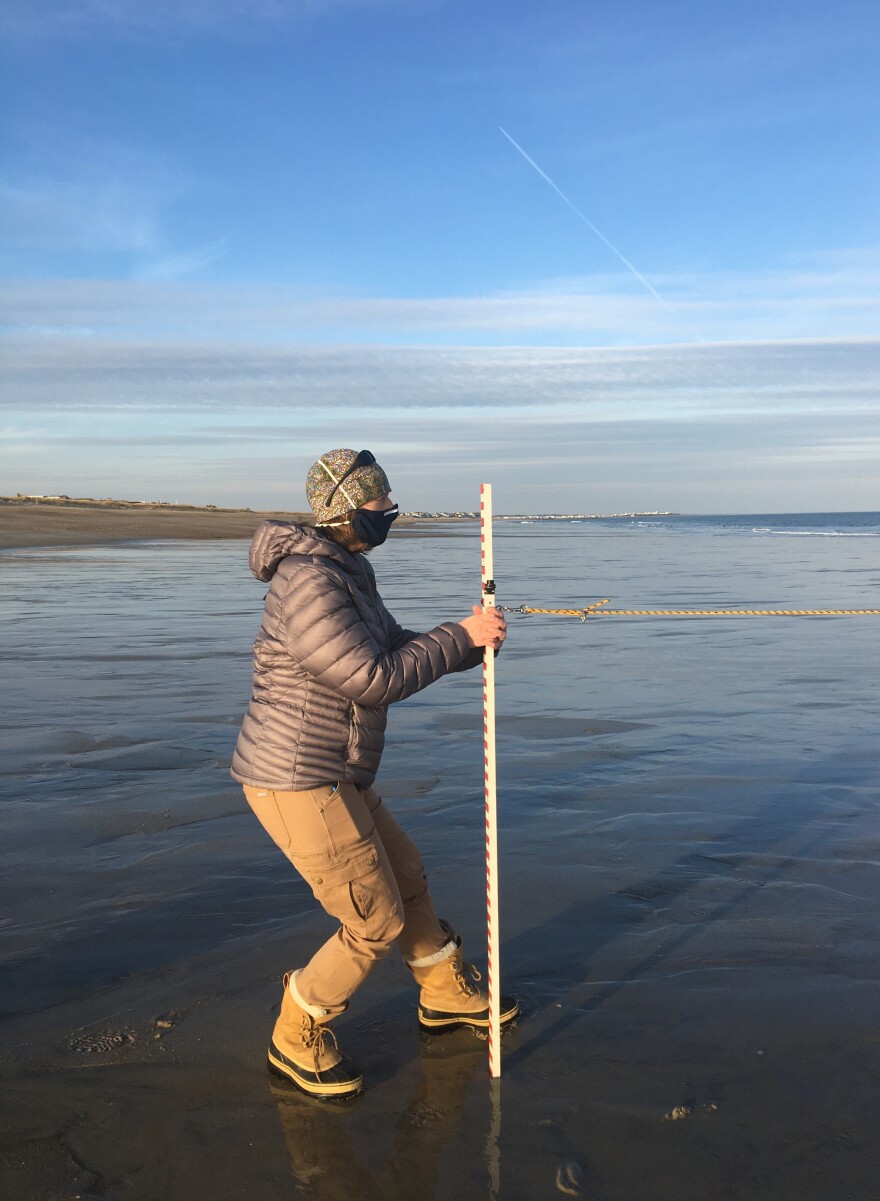Even in the quietest of times, sand beaches are defined by movement and change.
“I think it's fair to say the beach is one of the most flexible or dynamic, if you will, habitats in the world. It’s super geologically unstable,” said coastal ecologist Dr. Bianca Charbonneau, also known as “the Dune Goon.”
On this edition of 10x10, we examine the systems and feedback loops on and around the sand beach, the science taking place there, and how the way beaches are changing is itself changing in a changing world.
A beach responds to a storm
“I don’t know what it is about a beach in winter. But there’s something that I find truly magical. There's just something so incongruous about snow on the beach,” said Diane Cardwell, standing on the beach at Rockaway in New York in February 2021. “But I think that’s only because that’s how we are used to using it. It’s always here.”
Diane is a writer, and she started spending a lot of time at Rockaway after what might be described as a mid-life crisis. She had just gone through a divorce, and was dealing with fears that she would never be happy again.
But then, she discovered surfing.
“And I was terrible, just terrible. Still, I’m not very good. But I loved it. I managed to get to my feet for just a few seconds, and I just was so in love with that feeling, just gliding across the water as if you’re some kind of magical creature,” said Diane.

“The board sort of disappears and you become part of the ocean, and part of this kind of cosmic force that is energy in water making waves.”
Diane fell so in love with surfing that she ended up moving to Rockaway, and in 2020, published a memoir, Rockaway: Surfing Headlong into a New Life.
Rockaway is in Queens, on a peninsula at the western edge of Long Island. It’s famously a surf town: people come in from Brooklyn or the city for the day, to surf, hang out, watch the waves. Plus, there’s also a solid local, year-round community.
All that, on a spit of sand on the edge of the Atlantic Ocean -- a very tenuous spit of sand. Just how tenuous came into sharp relief just a few months after Diane moved in.
October, 2012. Hurricane Sandy hit. Diane had decided to defy the evacuation order and stay. When she emerged from her house after the storm, the beach had been hollowed away.
“Sand everywhere where it shouldn't be, no sand where it should be,” said Diane. “Basically, the beach was on our block. Hills and valleys and rivulets, and then these weird half-block-long sections of the boardwalk, which were still entirely intact.”
Diane saw firsthand how a sand beach can respond to a storm. The beach… can move.
But even in the quietest of times, beaches are defined by movement and change -- partly because of the physics of what they’re made of: sand.
Why are beaches made of sand? What even is sand?
In the ice-free world, just over 30% of shorelines are sandy. Sand is a type of soil particle, which are categorized by size. Sand is, essentially, very small rocks.
“Sand can be as fine as flour… or as coarse as a grain of salt. Anything smaller than flour would be classified as silt and anything larger than [a] pinhead would be classified as gravel,” said Donya Frank-Gilchrist, a research oceanographer and a coastal engineer, currently contracting with the US Geologic Survey St. Petersburg Coastal and Marine Science Center, in St. Petersburg, Florida.
Beach sand often comes from rivers. River currents pick up and carry rocks to the coast, wearing them down as they travel until they are sand-sized.
Sand also forms at the coast from wave action, wind, and other weather forces.
The composition of sand varies depending on the location. In Hawaii, for instance, black sand beaches form from broken down lava. In many places in the Carribean, the sand contains a lot of coral. On Okinawa, off Japan, the beaches have “star shaped sand,” which are actually the tiny shells of a single-celled organism called Foraminifera.
“In some regions, sand also comes from poop of parrotfish that eat algae from ocean rocks and coral reef,” said Donya.
But overwhelmingly, sand is mostly quartz, the second most abundant mineral in Earth’s crust, made of silica and oxygen. Quartz is relatively stable and pretty hard, so quartz sand is what remains after most everything else is blown or washed away.
The movement of sand: the accretional and erosional beach
“The beach essentially is constantly changing. It’s either accreting, or building up, or eroding,” said Larry Ward, research associate professor with the University of New Hampshire Center for Coastal and Ocean Mapping, where he studies the changes and forms that beaches take.
Measuring how a beach changes is hard because a beach is always changing. The beach has two classic profiles: accretional and erosional.

First, the accretional beach.
Consider a classically ideal sunny day in August on the beach in New England. The beach is nice and wide, and perhaps you’d pick a nice, sunny spot a little way back from the waves to pitch an umbrella.
“The upper beach - the backshore, the place where you tend to put your blankets - would have a higher elevation,” said Larry.
Once you’re ready for a swim, you head down to the water, or low tide terrace - and indeed, you move down a slope. There’s a big berm just before you reach the swash zone, where waves are breaking against the shore.
Generally speaking, this is the classic summer beach: there’s lots of sand on the shore.
But then — as happens often in winter — a storm rolls in.
The wind and waves eat into the berm, that sand savings account, resculpting the beach to the second classic profile: the erosional beach, often seen in winter.
It’s flatter, narrower, and lower. Even the composition of the beach itself changes: finer sand grains get carried away, leaving coarser grains and pebbles behind.
This sand, churned up and suspended in the water column, drifts down the beach and offshore, but it doesn’t disappear. Eventually it does sink -- often, forming a sandbar.
As powerful winter waves continue to move into shore, they break against the sandbar before they get to the beach, so some of that powerful energy gets dissipated, mitigating the force of those eroding waves.
This flexibility means the beach has a self-protective mechanism built-into its basic structure.
Eventually, the season of storms ends and the beach starts to rebuild as gentler waves push the sand landward.
But time is a key factor: the beach needs a break between storms to recover.
Measuring the changing beach
“This storm-buffering capacity is really one of our first defenses against storms, and increasing storms and severity of storms with climate change and rising seas,” said Alyson Eberhardt, coastal ecosystems specialist with NH Sea Grant and the University of New Hampshire Cooperative extension.

Together, she and Larry help run a community science project with NH Sea Grant. For the past five years, groups of volunteers measure the profiles of thirteen different beaches along New Hampshire’s Seacoast, to try to understand both how beaches are responding to storms and to get a broader sense of the trendline.
From the data, Alyson said, they’ve found that most beaches in New Hampshire are “sand-starved.” She expects that the project will be used to help coastal managers make choices about how to help protect the beaches in an era of increasing storms and sea level rise, and where valuable sand resources might be best put to beneficial use.
Dunes
Dunes are an important part of the beach system. More than a mere pile of sand, a developed dune system has a classic topography.
“There’s ridges in the system,” said Charbonneau, “the Dune Goon.”
The ridge closest to the ocean is called the foredune - the most exposed and stressful environment. Behind it, there’s a little valley called the interdune; and behind that, there’s another ridge called the secondary dune, or backdune.
Globally there are only a handful of plants that can withstand the extreme environment of the dune. In the Mid-Atlantic region, dunes are characterized by one plant in particular: American beachgrass, or Ammophila breviligulata.
Not only can beachgrass withstand the dune’s extreme environment, it also helps create dunes. A dune is a kind of habitat that’s called bio- or eco-geomorphic: the organisms contribute to shaping the landscape. Essentially, any obstruction on the beach can be significant because it could start to help form dunes.
“There’s this unique feedback between the plants or the ecology of the system and the geological processes,” said Bianca. “This wind-blown sand is approaching a plant, it hits the plant it falls to its base, and it accumulates over time.”
Grain by grain.
Each individual mound of sand is called a nebkah, an Arabic word meaning “small sandy hillock.” They’re sand dunes that form around vegetation.
Nebkah can encroach on other nebkah, changing the flow pattern and catching more and more sand grains.
“Over time, we think about seven years, you will get a dune... a continuous ridge,” said Bianca.
By virtue of its growing conditions (that it also helped create), beachgrass has to be able to handle getting buried, growing faster and taller to get out from under the sand.
But the thing that beachgrass really can’t handle is being walked on.
“There’s a good chance if you're walking on the dune, you're breaking them. The actual roots of plants itself are also sand-colored and very fine.. these can break without you knowing at all,” said Bianca.
The dune is also a habitat and wildlife corridor, populated by raptors like hawks or snowy owls, in pursuit of rodents like voles. The farther from the ocean, the more plants and animals that can survive, because the environment gets less extreme.
Shrubs like northern bayberry, wax myrtle, beach plum might be found in the backdune. Eventually, the dunes transition into maritime forest.
But maritime forests are threatened - in fact, the maritime forest at Seabrook beach is the only one left in the state of New Hampshire.
Beach nourishment
A few years ago, one late winter or early spring, Donya Frank-Gilchrist went on a beach vacation with her family.
“When we got there, we saw the sign up and there were bulldozers and tractors and all this huge construction equipment that you don't typically expect to see at a beach,” said Donya.
Donya was witnessing a beach nourishment project, in which sand is trucked in to build up a beach or replace sand that might have been lost.
Despite the lack of peace and quiet Donya had been seeking, she was interested “to see it in action, because as a scientist I study it all the time.”
A resilient beach needs a supply of sand. But sand takes millions of years to form. It’s not an unlimited resource.
Sand replenishment, generally speaking, is the kind of intervention that becomes necessary to maintain the existence of a beach when the overlapping systems that once supported - and in fact, created - the beach are no longer intact.
Seawalls
Seawalls can also contribute to the need for sand replenishment.
For instance, New Hampshire’s North Beach is in an area with a classic boardwalk vibe: pizza joints, ice cream stands, arcades, beachy cottages facing the waves… and a seawall.
“At these beaches, there's not much space at high tide. There’s not much beach available for putting your blanket down or your chair, so these are mostly used at low tide and that’s because they’re just much narrower beaches and have a lot less sand,” said Alyson.

There’s a few reasons that the beach is narrower, like the shape of the coastline, for instance. But another reason is the road that runs parallel to the ocean, right where the dune used to be -- one of the systems that helps sustain the beach.
“Sand dunes are an important source of sand storage and so they can serve to help replenish beaches and just keep a high supply of sand in the system. And we don’t have that here, where there are seawalls,” said Alyson.
When there’s no dune, the way that a beach erodes and responds to storms is very different.
“You can think of the dune kind of like an onion, where a wave is hitting and it’s absorbing the destructive power of that wave by sloughing off a layer of sand, and, again, that sand is aggregated or clumped and stabilized by the roots. The roots are acting… like a spider net. It’s not just a free-for-all, loose sand in there,” said Bianca Charbonneau.
“Individual layers of sand are being pulled away with each wave, and so the dune is, in theory, getting thinner and thinner and thinner.”

A vertical seawall, by comparison, has no layers. The sand has nowhere to go.
“So, you’re getting accelerated erosion right at the base of that sea wall, as well as when water is pulled out back to the ocean,” explained Bianca.
Not all seawalls are created equally. Some are designed to mitigate this effect. But the bottom line is: seawalls are intended to protect what’s behind them; they are not designed to protect the beach.
In December 2020, ProPublica and the Honolulu Star-Advertiser published an article on seawalls in Hawaii. It was headlined “Hawaii’s Beaches Are Disappearing,” and laid out how even though Hawaii has a “no tolerance” policy for new seawalls, local officials granted exemptions to this policy to over 230 homeowners and hotels, allowing them to keep or install seawalls and sandbags in front of their structures. Others were built without any approval at all.
So not only does this mean that sometimes public beaches and space is lost - but it also means that the mechanism - the movement of sand, which can protect the beach - no longer exists.
Living shorelines
It might be possible, though, to protect seaside communities in a way that doesn't wash away our beaches. A hybrid, of sorts, between the rigidity of the seawall, and the responsiveness of the dune. In recent decades, there’s been a general movement toward "living shorelines,” which combine structural elements like rocks and trees with plants and nooks for habitat rather than a poured concrete wall. Sometimes these designs can include beach nourishment as an element.
But, if it takes about seven years to see a really established dune, living shorelines also take time to establish.
“I think that a seawall offers immediate comfort and it’s rigid, versus a plant which will support the habitat over time and is more of a long-term investment,” said Bianca. “But it also takes time to build up habitat and you don't know what's coming at you.”
We don’t really know what’s coming at us. Even in places where it’s possible to build a restored dune, we still have the challenge of sea level rise and bigger, more frequent, and more intense storms.
During Hurricane Sandy, the Army Corps of Engineers estimated that more than 1.5 million tons of sand were “torn” from Rockaway beach, where writer and surfer Diane Cardwell still lives.
After Sandy, it took a little while for Diane to get back in the water. She said that surfing didn’t feel right while people’s basements were filled with mud; plus, a couple local sewage treatment plants had flooded and it wasn’t safe to go surfing.
By the time she did get back in the water, it wasn’t just the beach that had shifted. The waves had changed too.
“It’s a beach break, so most of the waves, not all of them... are made by sandbars, and those just shift with the way the water moves things around,” said Diane. “Most waves in Rockaway are ‘lefts,’ meaning that you ride them to the left. But I remember people being very excited that this ‘right’ seemed to have emerged, somewhere in the middle. Because depending on which way you like to surf with either your left or your right foot forward - one direction is just easier and more comfortable. So that’s really the only big difference that I remember, was, “oh, dude, did you see that right?!”
And in the years since the storm, Rockaway has been fortified with a combination of hard structures, like groins and seawalls, as well as living shoreline approaches: reconstructed dunes, planted grass, and huge quantities of sand, poured onto the beach and into the ocean.
“And that just killed the wave. So for, like, an entire season, there was no wave to be had,” said Diane. She ended up spending time at a much farther break, an “old school” spot where the old-timers used to hang out - a spot which, when asked for its location, Diane laughed and declined to say.








